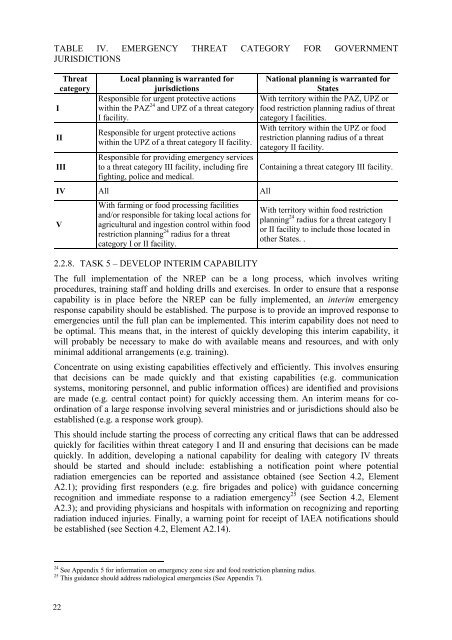epr-method (2003) - IAEA Publications - International Atomic Energy ...
epr-method (2003) - IAEA Publications - International Atomic Energy ...
epr-method (2003) - IAEA Publications - International Atomic Energy ...
You also want an ePaper? Increase the reach of your titles
YUMPU automatically turns print PDFs into web optimized ePapers that Google loves.
TABLE IV. EMERGENCY THREAT CATEGORY FOR GOVERNMENT<br />
JURISDICTIONS<br />
I<br />
Threat<br />
category<br />
II<br />
III<br />
Local planning is warranted for<br />
jurisdictions<br />
Responsible for urgent protective actions<br />
within the PAZ 24 and UPZ of a threat category<br />
I facility.<br />
Responsible for urgent protective actions<br />
within the UPZ of a threat category II facility.<br />
Responsible for providing emergency services<br />
to a threat category III facility, including fire<br />
fighting, police and medical.<br />
IV All All<br />
V<br />
With farming or food processing facilities<br />
and/or responsible for taking local actions for<br />
agricultural and ingestion control within food<br />
restriction planning 24 radius for a threat<br />
category I or II facility.<br />
National planning is warranted for<br />
States<br />
With territory within the PAZ, UPZ or<br />
food restriction planning radius of threat<br />
category I facilities.<br />
With territory within the UPZ or food<br />
restriction planning radius of a threat<br />
category II facility.<br />
Containing a threat category III facility.<br />
With territory within food restriction<br />
planning 24 radius for a threat category I<br />
or II facility to include those located in<br />
other States. .<br />
2.2.8. TASK 5 – DEVELOP INTERIM CAPABILITY<br />
The full implementation of the NREP can be a long process, which involves writing<br />
procedures, training staff and holding drills and exercises. In order to ensure that a response<br />
capability is in place before the NREP can be fully implemented, an interim emergency<br />
response capability should be established. The purpose is to provide an improved response to<br />
emergencies until the full plan can be implemented. This interim capability does not need to<br />
be optimal. This means that, in the interest of quickly developing this interim capability, it<br />
will probably be necessary to make do with available means and resources, and with only<br />
minimal additional arrangements (e.g. training).<br />
Concentrate on using existing capabilities effectively and efficiently. This involves ensuring<br />
that decisions can be made quickly and that existing capabilities (e.g. communication<br />
systems, monitoring personnel, and public information offices) are identified and provisions<br />
are made (e.g. central contact point) for quickly accessing them. An interim means for coordination<br />
of a large response involving several ministries and or jurisdictions should also be<br />
established (e.g. a response work group).<br />
This should include starting the process of correcting any critical flaws that can be addressed<br />
quickly for facilities within threat category I and II and ensuring that decisions can be made<br />
quickly. In addition, developing a national capability for dealing with category IV threats<br />
should be started and should include: establishing a notification point where potential<br />
radiation emergencies can be reported and assistance obtained (see Section 4.2, Element<br />
A2.1); providing first responders (e.g. fire brigades and police) with guidance concerning<br />
recognition and immediate response to a radiation emergency 25 (see Section 4.2, Element<br />
A2.3); and providing physicians and hospitals with information on recognizing and reporting<br />
radiation induced injuries. Finally, a warning point for receipt of <strong>IAEA</strong> notifications should<br />
be established (see Section 4.2, Element A2.14).<br />
24 See Appendix 5 for information on emergency zone size and food restriction planning radius.<br />
25 This guidance should address radiological emergencies (See Appendix 7).<br />
22

















